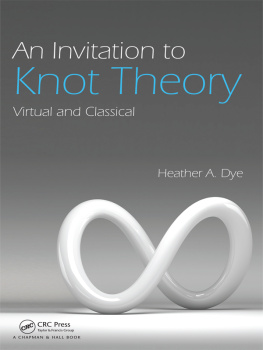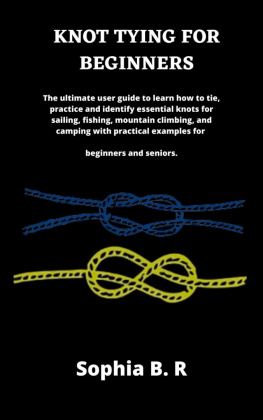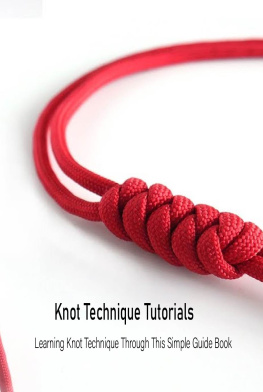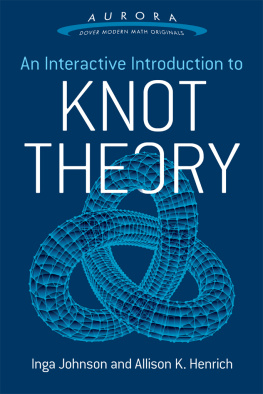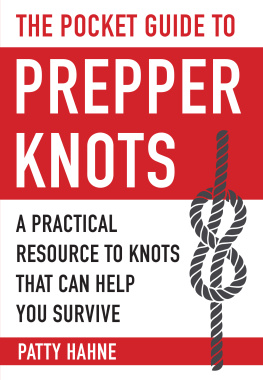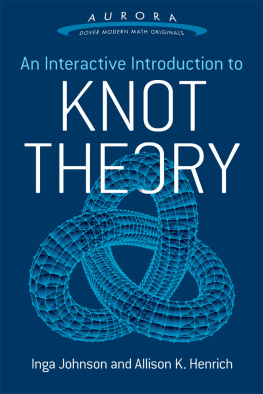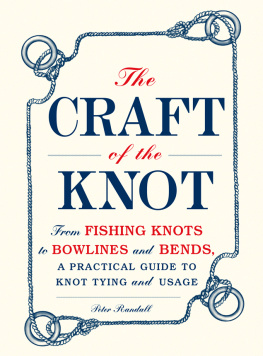An Invitation to Knot Theory
Virtual and Classical
Heather A. Dye
McKendree University Lebanon, Illinois, USA

CRC Press
Taylor & Francis Group
6000 Broken Sound Parkway NW, Suite 300
Boca Raton, FL 33487-2742
2016 by Taylor & Francis Group, LLC
CRC Press is an imprint of Taylor & Francis Group, an Informa business
No claim to original U.S. Government works
Printed on acid-free paper
Version Date: 20160113
International Standard Book Number-13: 978-1-4987-0164-8 (Hardback)
This book contains information obtained from authentic and highly regarded sources. Reasonable efforts have been made to publish reliable data and information, but the author and publisher cannot assume responsibility for the validity of all materials or the consequences of their use. The authors and publishers have attempted to trace the copyright holders of all material reproduced in this publication and apologize to copyright holders if permission to publish in this form has not been obtained. If any copyright material has not been acknowledged please write and let us know so we may rectify in any future reprint.
Except as permitted under U.S. Copyright Law, no part of this book may be reprinted, reproduced, transmitted, or utilized in any form by any electronic, mechanical, or other means, now known or hereafter invented, including photocopying, microfilming, and recording, or in any information storage or retrieval system, without written permission from the publishers.
For permission to photocopy or use material electronically from this work, please access www.copyright.com (http://www.copyright.com/) or contact the Copyright Clearance Center, Inc. (CCC), 222 Rosewood Drive, Danvers, MA 01923, 978-750-8400. CCC is a not-for-profit organization that provides licenses and registration for a variety of users. For organizations that have been granted a photocopy license by the CCC, a separate system of payment has been arranged.
Trademark Notice: Product or corporate names may be trademarks or registered trademarks, and are used only for identification and explanation without intent to infringe.
Visit the Taylor & Francis Web site at
http://www.taylorandfrancis.com
and the CRC Press Web site at
http://www.crcpress.com
To my husband Donovan and my children, Rowan and Gareth, and my family and friends
Preface
This book is an introduction to virtual and classical knot theory. The book is designed to introduce key ideas and provide the background for undergraduate research on knot theory. Suggested readings from research papers are included in each chapter. The goal is for students to experience mathematical research. The proofs are written as simply as possible using combinatorial approaches, equivalence classes and linear algebra so that they are accessible to junior-senior level students.
I enjoy explaining virtual knot theory to undergraduate students. In the combinatorial proofs, I find examples of many of the concepts that we to try to introduce students to in a course on proof writing. Undergraduates have also experienced a high level of success in projects relating to virtual knot theory. For example, in 2003 Anatoly Pregal won 3rd place in the 2003 Intel Science Talent Search for a project entitled Computation of quandle cocycle invariants. (Quandles are one of the topics in this book.) Virtual knot theory is a field where undergraduates can experience research in mathematics in a way that results in peer reviewed, publishable research. Another wonderful aspect of studying virtual knots is that it is current research. Students could contact many of the researchers mentioned in this text and participate in the mathematical community.
To write this book, I've drawn on resources that include research articles on virtual knot theory and classic texts on knot theory. Virtual links are the central topic in this book; classical links are a subset of virtual links. The virtual link invariants defined in this text are invariants of both classical and virtual knots. Proofs of invariance are written for virtual links and as such apply to classical knots. For this reason, the proofs are sometimes different from the proofs in classical texts. Well-known applications and results for classical knots and links are also covered in the text. For example, the fundamental group of knot is defined in this text, but our main attention is on the knot quandle (of which the fundamental group of a knot is a homomorphic image).
Classical knot theory originated in the 1880s with Lord Kelvin's proposal that atoms were knotted vortices in the ether. The subject grew from there with P. G. Tait's construction knot tables. The Reidemeister moves were introduced in the 1920s by Kurt Reidemeister's in his article Knotentheorie. The Alexander polynomial invariant was introduced in the 1928 article, Topological invariants of knots and links, published in the Transactions of the American Mathematical Society . The Alexander polynomial was the main invariant of knots until the introduction of the Jones polynomial in 1985. Much work was done in the area of knot theory involving hyperbolic geometry and topology, but a main focus of this text is the normalized f -polynomial which is related by a change of variables to the Jones polynomial. The Jones polynomial was introduced in a 1985 article, A Polynomial Invariant for Knots via von Neumann Algebras, published in the Bulletin of the American Mathematical Society by V. Jones. This polynomial was quickly followed by the HOMFLY-PT polynomial and a skein relation introduced by Louis Kauffman in 1985. The development of this work encompassed a hundred year span.
In comparison, the development of virtual knot theory spans only twenty years. Virtual knot theory was first defined by Louis Kauffman as an extension of classical knot theory in 1996. Kauffman's paper Virtual knot theory was first published in the European Journal of Combinatorics in 1999. Kauffman's paper immediately introduced extensions of the fundamental group and the f -polynomial to virtual knots and links. Topological interpretations of virtual knots as embeddings of links in thickened surfaces modulo isotopy and stablization have followed. In 2003, Greg Kuperberg proved that each virtual link has a unique minimal genus surface in which the virtual link embeds. Additionally, there are other topological interpretations. Virtual knots have also led to the development of different invariants related to the biquandle and quandle structures, as well as finite type invariants of virtual knots. There are deep connections between virtual knots and algebraic and topological structures. However, the combinatorial structure of virtual knots opens the field to the undergraduates. The fun of virtual knots is working on these multiple levels; invariants and results can be developed independently of these connections (although the knowledge of the connections certainly inspires the results).
This book is written for students who have completed the first two years of a mathematics major. I assume that students have completed linear algebra and a three semester calculus sequence. The book is intended as a gentle introduction to the field of virtual knot theory and mathematical research. For this reason, references are formatted somewhat differently from a research monograph a list of undergraduate-friendly references is given at the end of each chapter. The complete list of references for each chapter is given as an appendix in the back of the book. I've also explicitly written out references and information about original papers in the body of the text.

